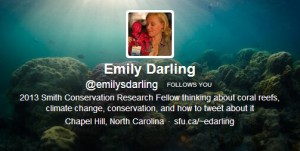Tweeting for Conservation Science and Beyond
This is a Q&A with Emily Darling on the use of social media for scientists and science communicators. Emily has conducted research with @WhySharksMatter on how Twitter can benefit conservation scientists. Emily is a marine ecologist working towards real world conservation and management solutions for the challenges facing our oceans. Her research focuses on multiple stressors, climate adaptation and marine reserves on tropical coral reefs. I interview her electronically below:
Me: You have written and researched extensively on the benefits of social media, including Twitter, for scientists. How have social media tools helped you personally as a scientist? (or as a scientist communicating about science?)
Emily: Honestly, I can’t imagine my science without social media. Checking a Twitter or Facebook feed allows me to take the pulse of what’s going on in my field. I feel more up-to-date on recent papers and research news, more connected to my colleagues around the world, and it’s been pretty incredible to having access to a real-time group of scientists online. I’ve tweeted a question about research methods or statistics and gotten a response back in less than five minutes!
I also use Twitter to network beyond scientists. I follow journalists, NGOs, federal science agencies and politicians to see what issues they’re interested in and think about how my science can fit into real-world outcomes. For example, my postdoctoral research focuses on climate change planning for coral reefs in the US Pacific. I follow the Twitter feeds of several US management agencies like NOAA, the National Marine and Fisheries Service, the US National Marine Sanctuaries, US Fish and Wildlife. If they’re tweeting about climate change, coral reefs of the US Pacific Islands, I know I need to get involved in the conversation in order to link my science into a timely issue. Tweeting about my research has also made me more available to journalists – I’ve been interviewed by more journalists based on my Twitter feed than from traditional press releases! I’ve found social media to be an incredible useful way to ‘break the ice’, in terms of building connections and community. But it’s also important to remember that face-to-face conversations build relationships. While social media has many benefits, don’t forget to get offline and make those personal connections through phone calls, meetings and conferences.
Me: How can scientists and/or science writers benefit most from these social media tools, and/or how can they use them most effectively? Does it depend on their goals?
Emily: I think there are lots of ways to benefit from using social media as a scientist. Twitter is great to find out about lots of things fast, to see what other people are talking about and to build networks across scientists, managers and the public. Facebook is better for posting photos and videos and being able to talk about an issue in more than 140 characters. Blogging is another way to really flesh out an issue. Obviously there’s a different time commitment and figuring out which social media tool to use will depend on your goals and ultimately, your audience. It’s worth thinking about who you want to talk to about your science: the general public, your scientific colleagues, the media or another audience entirely. To catch anyone’s interest, you need to pitch a catchy or interesting story, even in 140 characters of a tweet!
Me: What advice would you give to scientists or science writers beginning their venture into social media?
Emily: The best advice I could give is just to give it a try! Sign up for Twitter, make a Facebook page for your research group, find a colleague who blogs and write a guest post about your work. Don’t worry about a ‘right’ way to do it or the ‘right’ thing to say – there isn’t a right way! There’s only the way that works for you. At the beginning, I would agonize over writing 140 characters of a tweet thinking that I was writing the wrong thing. But after nearly two years on Twitter with over 2200 tweets and nearly 1000 followers, I can tell you that it gets easier! Give it a try, keep it up and I bet you’ll be surprised at how easily you can find your own voice on social media.
"Conservation scientists are starting to share their research findings over Twitter, cultivating an audience for their scientific research. Darling and colleagues (2013) identified 116 marine scientists who actively tweet, a conservative estimate to be sure because many scientists may tweet under pseudonyms and more are joining Twitter every day." For more information on tweeting for conservation science, see How Twitter Literacy Can Benefit Conservation Scientists.

